
I will be spending the holidays with family. I don't know if I'll have any time to blog, so if I don't get to say it later, Merry Christmas and Happy New Year!
P.S. Poohtie Cat says Happy Holidays, too.
A place to explore the connections between community and sustainability. Feelings are welcome.

Connect your appliances into the Kill-a-Watt, and assess how efficient they are. A large LCD display counts consumption by the Kilowatt-hour just like utility companies. You can figure out your electrical expenses by the hour, day, week, month, even an entire year. Monitor the quality of your power by displaying Voltage, Line Frequency, and Power Factor.
The Smart Strip Power Strip features advanced circuitry that not only offers excellent power surge protection and line noise filtering, but is actually able to 'sense' the flow of electrical current through the strip's control outlet. Because of this unique ability, the Smart Strip can turn off selected equipment when its not in use -- creating benefit that no other power strip on the market today can offer.

 Jib Jab has done it again. I just saw their new video--"2-0-5" in review--on CNN. And I'm still chuckling. Have at it.
Jib Jab has done it again. I just saw their new video--"2-0-5" in review--on CNN. And I'm still chuckling. Have at it.
[t]he first step in addressing any problem is to understand it. We need a really good definition of the challenges that lie ahead--technical, social and economic. Thus we start with a thorough review of the energy market. We need a realistic forecast of America's energy requirements by fuel type by year for the next 20 years. Fuel types fall into two basic categories: fuels for mobile applications (cars, trucks, railroad engines, airplanes, etc.), and fuels for stationary applications (power plants, furnaces, generators, pumps, industrial motors, etc.). Then we need a forecast of fuel resources by type by year for the same 20 year period. The supply forecast must include a conservative estimate of resource depletion, potential political challenges, and international competition for available fuels. Our market plan should also examine future cost/price trends and their potential impact on our economy.Cooke goes on to describe the "three key components of a successful business plan." It would be administered by a large organization that must manage the project. None of the components are in the 2005 act.
Where shortages appear in our forecast--and they will--we need to review alternative solutions. Again, there are two categories: energy efficiency and new resource development. Since energy efficiency improvements provide us with the quickest and cheapest solution, all avenues of improved energy efficiency must be defined and quantified. The remaining energy shortfall defines the annual fuel volume requirements of our resource development objectives.
With this Fourth Draft, we have refined our focus, sharpened our message and begun to build the financial models to support the plan, including both a funding model and target investments for each specific proposal.It sets a legislative agenda for transportation, power generation, the environment and regulatory framework, efficiency and education, and funding the campaign. The authors are asking for feedback on several levels: rhetorical, political, cost/benefits, and even the wording.

My background is in the teaching of permaculture for many years, giving people the tools to create more sustainable ways of living in their own gardens and families. Since I found out about peak oil, I have become fascinated by how we apply these principles to whole towns, whole settlements, and in particular, to how we design this transition in such a way that people will embrace it as a common journey, as a collective adventure, as something positive. So much peak oil and other environmental literature is doom-laden and information heavy, and most peoples’ reaction is to switch off. How can we design descent pathways which make people feel alive, positive and included in this process of societal transformation?It is heartening to read, in fact he makes a conscious decision to include Heart in his work:
In September 2005 I moved to Totnes in Devon, to begin a PhD at Plymouth University looking at Energy Descent Action Plans, refining the model in such a way that they can be done anywhere. This involves looking at what I call the Head, the Heart and the Hands of Energy Descent. By the Head I mean the concepts of peak oil, arguments for and against localisation as well as any historical examples that we can learn from. The Heart refers to exploring how to actually engage communities in a positive and dynamic way, how to use peak oil as a tool for empowerment rather than leaving people feeling helpless. This part of the exploration is about how to actually facilitate change, and the dynamics of cultural transformation. The Hands refers to the practical aspects, could the UK become self sufficient in food and how? How much well managed woodland would it take to heat a town with efficient CHPs? Can local materials be used to retrofit houses?
This reminds me of the 4H pledge that Mr. Logan taught me:
I pledge My head to clearer thinking,
My heart to greater loyalty,
My hands to larger service, and
My health to better living,
For my club, my community, my country, and my world.
I thouroughly enjoyed every entry and invite you to visit often.
Dear Members:He goes on to say that they will send out an energy professional to our homes to discuss how we can lower our energy usage.
Those of you who have lived in Georgia for at least one summer know that, on a hot summer afternoon when the clouds get dark and you hear thunder off in the distance, we are about to have a storm. People adjust their plans and get ready for what might come.
Currently, we are hearing the thunder of increasing energy costs and seeing the darkening clouds of a tightening energy supply of the various raw commodities used to produce electric energy. It appears that this is the prelude of what "might" come very soon, increased electrical rates.* With the tightening of the supply of coal and natural gas, two (2) of the most popular fuels used in the production of electric energy, coupled with record increases in the commodity price of these fuels, many people believe we are on the verge of a 1970s style energy crisis. We are not ready to sound that alarm just yet but want you, our members, to be aware that the "sky is getting dark" and like with that afternoon storm, we need to prepare...
 I am back from a very empowering weekend produced by Community Solutions and hosted by the Center for Sustainable Community at Stelle in Illinois.
I am back from a very empowering weekend produced by Community Solutions and hosted by the Center for Sustainable Community at Stelle in Illinois. The first shows the peak of US production.
The first shows the peak of US production.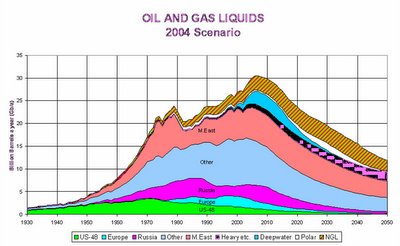 The third is world oil production.
The third is world oil production.
Several hours or so later with buckets, shovels, a rake, gallons of bleach, and garbage bags piled high in the back of the rented minivan, we arrived at Lester’s home, donned gloves and masks and plunged into work. His home is quite big and we literally attacked each room. We were determined to get the muddied, molded and waterlogged furniture, appliances and stuff out of the house and onto the curb. Having a deadline of only a few days to work kept us moving even as the stench permeated into our brains with a dull headache, the waterlogged carpets and slime soaked floors threatened to spill us with one misstep and the itchy masks formed prickly goatees of sweat on our faces.The end by relfecting that Los Angeles, indeed the world, has its own "big one" that looms--are we really ready to be without power, water and infrasturcture?
For those who want not to just read about peak oil or the end of the world scenarios – go to New Orleans and find out first hand. Reading in the comfy of your surroundings is one thing; living the nightmare is another.
The implication is that we may not have much time to adapt to a post-peak world.


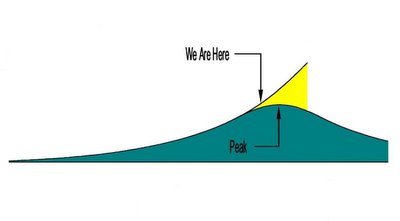

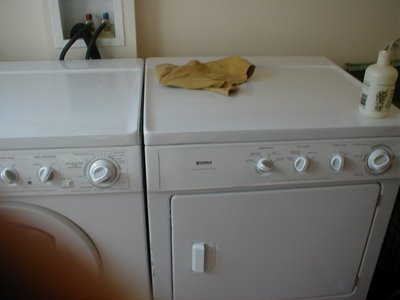

They did a beautiful job tiling the shower, so I had to take a shot of it.

This is their composting toilet. The gasmask is a joke. It has a fan in the tank below which pulls the air out of the bathroom.

This is the waste pipe for the toilet upstairs.
 The salvaged the beautiful oak floors from a schoolhouse slated for demolition.
The salvaged the beautiful oak floors from a schoolhouse slated for demolition.
 This stove heats the place with downed wood they collect. The house is so well insulated it doesn't take much to get warm. "Pancho" (a plastic Einstein doll) rides atop the cowboy hat.
This stove heats the place with downed wood they collect. The house is so well insulated it doesn't take much to get warm. "Pancho" (a plastic Einstein doll) rides atop the cowboy hat.
 They learned how to set tile on their screened in back porch. We got to meet Hemingway, who is a very friendly 5 month old.
They learned how to set tile on their screened in back porch. We got to meet Hemingway, who is a very friendly 5 month old.
We went out the back door for a look at the graywater system.
 It comes out these pipes...
It comes out these pipes...
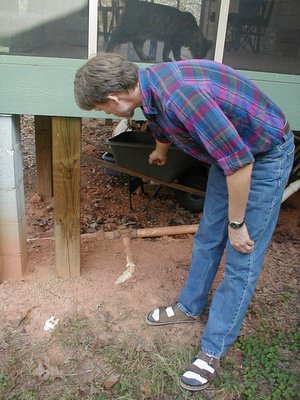 and gets sent to one of the two fields via this valve, which he switches every couple of weeks to let the mulch dry out...
and gets sent to one of the two fields via this valve, which he switches every couple of weeks to let the mulch dry out...
 and it comes out of this pipe into the drainage cachement which sends the water to nourish a fruit tree.
and it comes out of this pipe into the drainage cachement which sends the water to nourish a fruit tree.
Now its time for a trip to the basement to see the inner workings of the house.
 It was built with this insulating material, made of Styrofoam sandwiched between OSB. The ones in the outside walls are about 4" thick and have an R factor of 17. The ones on the roof are thicker.
It was built with this insulating material, made of Styrofoam sandwiched between OSB. The ones in the outside walls are about 4" thick and have an R factor of 17. The ones on the roof are thicker.
An airtight house means a ventilation system is needed. When people ask if they will get sick from a well sealed home, Allison responds that a home can't be too tight, just underventilated.
 This one exchanges heat between the air going in and going out. The next step up exchanges humidity as well.
This one exchanges heat between the air going in and going out. The next step up exchanges humidity as well.
 This pipe evacuates the radon from underground. Its easy to install if you do it when pouring the slab. The negative air pressure draws radon gas up and out the vent in the roof.
This pipe evacuates the radon from underground. Its easy to install if you do it when pouring the slab. The negative air pressure draws radon gas up and out the vent in the roof.
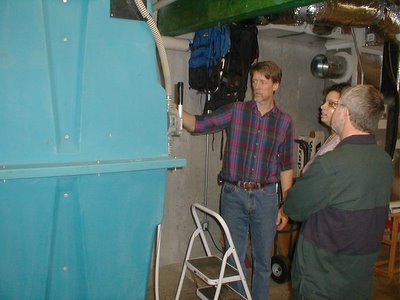 This is the tank of the composting toilet.
This is the tank of the composting toilet.
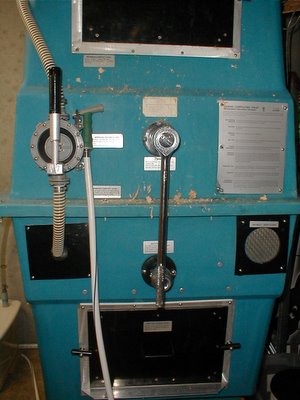 The sawdust gets stirred by tines attached to the top axel. The compost comes out of the bottom panel.
The sawdust gets stirred by tines attached to the top axel. The compost comes out of the bottom panel.
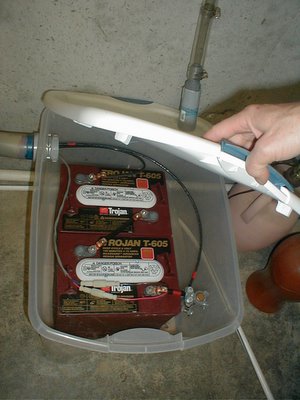 The fan and the light (to attract and kill mold gnats) is on a 12 volt system.
The fan and the light (to attract and kill mold gnats) is on a 12 volt system.
 The water pump is also powered by these batteries.
The water pump is also powered by these batteries.
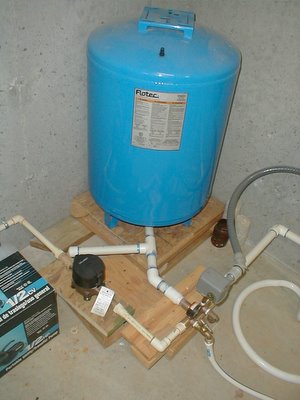 The water is pressurized in this tank.
The water is pressurized in this tank.
Now its time to tour the grounds.
 The greenhouse.
The greenhouse.
 A tractor from the 1940s that they got running with a little TLC and a lot of moola.
A tractor from the 1940s that they got running with a little TLC and a lot of moola.
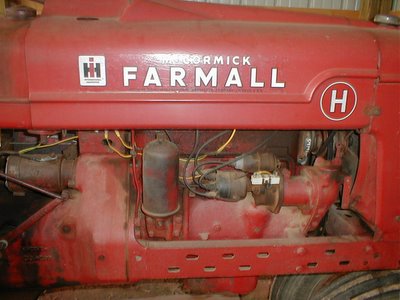 My hubby used to ride on one of these growing up on the farm.
My hubby used to ride on one of these growing up on the farm.
 Next year this area will have chickens and maybe goats. The mound is their compost pile.
Next year this area will have chickens and maybe goats. The mound is their compost pile.
 The garden/field is fenced off to protect it from the deer. Apple scented modules lure them and then shocks their noses. They learn to stay away instead of figuring out that they can jump the fence.
The garden/field is fenced off to protect it from the deer. Apple scented modules lure them and then shocks their noses. They learn to stay away instead of figuring out that they can jump the fence.
 The well is 302 feet deep.
The well is 302 feet deep.
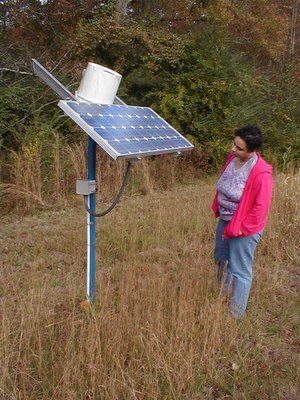 The pump is powered by this solar panel.
The pump is powered by this solar panel.
 We learned a lot and had a great time hanging out. Thanks for your hospitality, Allison, and thanks for coming everyone!
We learned a lot and had a great time hanging out. Thanks for your hospitality, Allison, and thanks for coming everyone!
If Peak Oil theory is now mainstream, splashed across the front page of USA Today and the theme of Chevron and BP ad campaigns, then Petrocollapse is a secular, left-wing, non-fiction version of Tim LaHaye's Christian Apocalyptic "Left Behind" series. The gospel according to Petrocollapse is that Peak Oil is coming, and it's coming soon. The transition to the post-carbon world will not be gradual, it will be sudden and massive. And when it comes, the sinners--those profligate American consumers and the corporate whores who oversee them--will all be swept away in violent social turmoil, starvation and environmental disaster. But there's good news too. After the tumultuous mass die-off, a new society will arise from the burned out SUV hulks and melted plastic detritus. In this post-carbon world, humans will have no choice but to live sustainably, in cooperation with each other and in harmony with nature. Those who get religion and accept Peak Oil into their hearts soon enough--they may be among the lucky survivors whose children grow to live in this new and better world.On the other hand, the next event was all about policy.
If the Petrocollapse conference was dominated by conspiracy theorists, then Winning the Oil Endgame" was the Conspiracy. Present on the dais were former CIA director James Woolsey, Mississippi Governor and former Republican National Committee Chairman Haley Barbour, former Deputy Secretary of the Treasury Robert Altman and Amory Lovins, CEO of the Rocky Mountain Institute.They promoted drilling, nuclear power, coal-fired electricity, natural gas and more efficient vehicles. Little mention was made of the "profound environmental problems and danger" of fossil fuels.
Far from doom and gloom, the Endgame speakers were nearly united in their belief that it was both possible and desirable to keep finding fixes for America's energy Jones and to keep the American consumer machine rolling along using new technologies.
Komanoff acknowledges the possible validity of the Peak Oil analysis, but having heard similar End Times prophecies thirty years ago, he isn't allowing the Peak Oil argument to guide his work and activism. "I think there's an element of wishful thinking and that some Peak Oil adherents are looking for a deus ex machina to sweep away the disaster that is contemporary industrial civilization," he said. "And understandably so. Waiting for Peak Oil is so convenient, so much simpler, and so much more seductive than the hard work of organizing for social and ecological change."Finally, Naparstek looks at the NYC Oil Awareness Meetup group. This is the same network that I am involved with so I was particularly interested in how other groups are developing. They deal with the emotional component and have started a subgroup formed to help people get through the paralysis that learning about peak oil brings. Philosophically, they have broken into two approaches: "The Relocalizers believe New York City won't be viable in the age of Peak Oil and are looking for new places to live and new skills to live in a world without modern conveniences. The Sustainable New Yorkers are dedicated to educating and preparing the city for what they see as a lengthy and potentially tumultuous energy crisis."
Komanoff was also critical of the Endgame analysis. "There is a big dissonance between Amory's kind of chirpy optimism and actual realities on the ground and actual energy trends." Three decades after Lovins unveiled his revolutionary "soft energy path," Komanoff points out, the U.S. uses 25% more oil, burns 75% more coal and generates 35% more greenhouse gases than it did in the mid-1970s. Though a 66 mpg SUV is certainly more desirable than Detroit's current state of the art, Komanoff doesn't believe Lovins' hyper car project provides us with real answers for our global energy and environmental quandary because the project is "only about improving the fuel efficiency of the vehicle and does nothing about addressing the social and whole system efficiency of travel and mobility and community."
In my group, similar distinctions apply. As one member put it, there are "three possible scenarios for the P.O. future, and I can actually argue in support of each:"Despite such dread, there is often a sense of action and possibility at the monthly meeting. Miner makes a point of emphasizing that there are things you can do to prepare for Peak Oil and people interested in doing them with you. At the Meetup, you aren't so much assaulted by the gloomy hopelessness that pervaded the Petrocollapse and Endgame conferences.
1) Nothing Happens (Yergin): Things keep going smoothly (with maybe a slight bump in the road), alternative energy sources are identified in time and the economy will continue to grow at 4% indefinitely-business as usual. The Deniers say, "Everything is fine."We found this to be an interesting starting point in identifying where each of us fell on the spectrum, and hope to create a group that can meet the needs of each.
2) Soft Landing (Simmons): The energy crunch causes, at minimum, a recession or possibly a full-blown depression. The US has been through recessions before and will weather this one. A global depression may result as the US economy falters and consumers stop spending but in the end. "We'll tighten our belts and pull through somehow."
3) Hard Landing (Kunstler): The worst case scenario is an economic and social collapse-the stuff of doomsayers' dreams. "Oh shit."
Some Peakniks come in somewhere between 1 and 2, or between 2 and 3. The optimistic 1.5ers see a problem, but believe we can address it-they're the Organizers and Activists. 1.5ers will push for education, political action and programs like carpooling, bike lanes, public transportation, and tax credits for installing solar.
The 2.5ers are the Preparers; they're less optimistic and will be more concerned with readying for a stark, downscaled future-learning about farmsteading and food storage, getting off the grid, learning self defense.
The 3-or-worse crowd (the Survivalists or Apocalyptics) will start hoarding food, buying rural property and stockpiling ammunition like a survivalist. (NOTE: None of these generalizations are intended to be judgmental; everyone has to follow their own instincts.)
Imagine the end of the world in moderation. It's hard. We tend to imagine that either the "economy" will recover and we'll go on like 1999 forever, plus flying cars, or else one day "the apocalypse happens" and every component of the industrial system is utterly gone.He denounces the images of people running wild in the streets. He starts out with the question of electricity: "When the lights go out, we won't go berzerk -- we'll go to bed earlier." Gasoline and water are dispatched. Food is more problematic, but he does not believe "the lack of food will make people kill each other." He has plenty of examples to counter that.
...[T]he interesting question is not "How will people die?" but "How will people live?" In the town next to the mass grave, what will we do all day? Process data and feign enthusiasm? Get on the internet? Make crossbows? Tend fruit trees? The best I can figure it out is to look at a bunch of more and less likely modifiers to the world as we know it, and think through how they could change things.He goes on to look at the effects of various possibilities, including peak oil, economic depression, WWIII, secret weapons, China, serial Falluja, disease, weather, astronomy, and finally, a human consciousness shift.

 This weekend I will be taking the first in what I hope to be a series of basic survival courses. So far my peak oil education has included basic first aid from the Red Cross, group facilitation from Communities at Work and this Plant Identification course from Medicine Bow. I'll tell you more when I get back. Have a safe weekend!
This weekend I will be taking the first in what I hope to be a series of basic survival courses. So far my peak oil education has included basic first aid from the Red Cross, group facilitation from Communities at Work and this Plant Identification course from Medicine Bow. I'll tell you more when I get back. Have a safe weekend!
I am of the opinion that while we each need to take individual action to prepare ourselves for an uncertain future, our ultimate survival will depend on how well our communities function. So I am very heartened whenever I hear of groups and communities coming together to address the challenges. Here are some links to homepages of some of these groups.
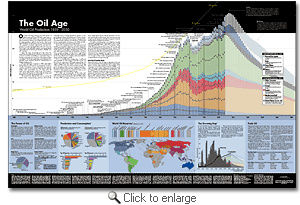 http://www.oilposter.org/ (Produced by the San Francisco Oil Awareness Meetup group)
http://www.oilposter.org/ (Produced by the San Francisco Oil Awareness Meetup group)
Colorful and authoritative, this poster traces the history of the Oil Age from its beginnings in the hills of western Pennsylvania in 1859 to its rise as the engine of global industrial economies. The poster's main chart features a year-by-year rendering of worldwide oil production from 1859 to 2050 with projections of future production based on Colin Campbell's Oil Depletion Model.
http://www.peakoilaction.org/ (Produced by the Los Angeles Oil Awareness Meetup group)
This website was created to further promote discussion about peak oil production, to focus on raising awareness in our community on this topic, and to create communities working torwards energy self-sufficiency.
http://eonsnow.org/ (San Diego Post Carbon Institute group)
This project is called "EONS Now" which is short for "End Oppressive Non-Sustainability NOW." (It could equally well mean "Earthlings Overwhelmingly Need Sanity NOW".) It is a project which aims to educate and enlighten people about the dominance of various forces which are non-sustainable at their core, what that means for society, and then what some options are for the future when these oppressive systems dissolve and become dysfunctional in the era of fading oil and gas supplies which allowed them to prosper. Despite there being a number of admittedly bleak topics covered, there is hope because we don't have to carry on this failed experiment. Envisioning a world with less corruption, pollution, alienation, and fear is a first step toward realizing such a world.
http://www.portlandpeakoil.org/ (Portland Oil Awareness Meetup group) 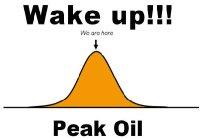
We're a grassroots group of concerned local citizens, from different backgrounds, with different interests, who've separately become aware of the looming crisis caused by the peaking of world oil supplies. WeÂ’ve come together to try to:
http://www.seattleoil.com/ (Seattle Oil Awareness Meetup group)
Seattle Peak Oil Awareness is a local citizens action network offering information and practical ideas for living in a time of reduced energy availability. Working in small, focused groups we advocate healthy, sustainable living choices for all interested residents in the Puget Sound region.
 http://www.willitseconomiclocalization.org/index.htm (Willits Economic LocaLization)
http://www.willitseconomiclocalization.org/index.htm (Willits Economic LocaLization)
The primary objectives of the Willits Economic LocaLization project are 1) to determine current resource use in the community of Willits, California (energy, transportation, food, housing, etc.), 2) to determine how that community can reduce its consumption of those resources imported, 3) to determine local resources that can replace those imported from outside the community and 4) to implement this transition towards a localized economy.
http://ibiblio.org/tcrp/doc/project.htm (Ithica, NY and surrounds project)
Every location will bring its own set of strengths and weaknesses to its struggle with the economic, social, and material consequences of the end of cheap oil. So unlike most sustainability plans, which apply now and apply almost universally to the U.S. and other developed countries, this project aims to develop a plan that will apply in the near future and will address the specific strengths and weaknesses of Tompkins County. This kind of plan is called "county relocalization." It is based on the belief that the size of counties and the traditional land use, welfare, and emergency management functions of counties puts them at the organizational level most appropriate to the management of emergency relocalization. In our case, it allows the plan to recognize and make best use of the unique blend of rural, town, and university resources in Tompkins County. The general outline of the TCRP may be applicable to other counties as well, but the objective is to map out in detail the measures to be taken right here.
http://www.sydneypeakoil.com/index1.html
Raising Sydney's awareness of global oil depletion and the possible consequences
Each of these websites and documents can serve as inspiration and modeling for our own local efforts. Want to get involved? One way to start is through Oil Awareness Meetup groups, another is through Post Carbon Institute Outposts. Either way will begin the process of getting to know your concerned neighbors. There may already be a group meeting near you. You've only got to loose your isolation!
Orr and McKibben were among the presenters to mention Peak Oil, which was not on this year's program as a separate topic. However, conference participants organized two discussions on Peak Oil. Dave Room of Post Carbon Institute explained to about 70 listeners that the underlying cause of high oil and gasoline prices is burgeoning demand for petroleum while supply nears its limits. Once the rate of global oil production peaks, Room says "we will no longer be able to rely on 6,000 mile supply chains for the goods we use on a daily basis. We will increasingly need to re-localize our food, water, energy, and money systems and begin manufacturing essential goods more locally."Hopefully next year Peak Oil will be in the scheduling consciousness. I'm pleased to hear about the turnout for the topic.
Richard Heinberg, author of "The Party's Over" and "Powerdown," explained to another 75 people the following day that "Peak Oil is the good news. It will lead to a collapse of industrial society. It will involve hardship for humanity, but eventually we will have to create the sustainable society that many of us have been talking about for years."


Founded in 1990, Bioneers is a nonprofit organization that promotes practical environmental solutions and innovative social strategies for restoring the Earth and communities.
They have a slogan: "It's all alive, its all intelligent, it's all connected, it's all relatives." They break it down this way:
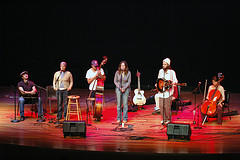
It's all alive.
ONE OF THE BEAUTIES OF BIOLOGY IS THAT ITS FACTS CAN BECOME OUR metaphors, and these underlying codes serve as inspiring parables for how we can organize a more just, humane and authentically sustainable society. Life has the answers to our problems. --> It's all intelligent.
It's all intelligent.
INTERDEPENDENCE ALSO TEACHES US THAT THERE ARE NO SINGLE ISSUES because it's one whole that can be addressed only by bringing together all the parts. Bioneers gathers people at the crossroads of ecological restoration, human health and social justice. There is only one cause - it is all of them -->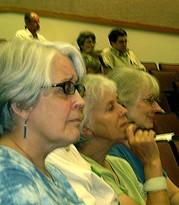
It's all connected.
THE BIONEERS SPAN ALL FIELDS, CULTURES, AGES AND WALKS OF LIFE. The work ranges from science to spirit - local to global - academia to the grass roots - farm to city - business to public service - art to engineering. We celebrate the gift of life in all its diversity and mystery, conjuring a change of heart to renew our empathic connection with the web of life and the Earth, our home. We are one -->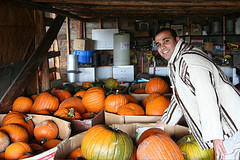
It's all relatives.
They have a blog that people from different locations contributed to, with both words and images. (The pictures are for you, Steve!)
We ended the day with a closing circle, and Juanita Hull-Carlson led us in a prayer she found in Whole Earth Magazine:I pledge allegiance to the earth, and all the life it supports. One planet, in our care, irreplaceable with respect and sustenance for all.
I thought this summed up the weekend.
The conference reaches beyond the borders of California:

For the fourth year in a row, the speeches given during the Bioneers Conference plenary sessions will be broadcast live via satellite in schools and communities around North America. We work with partners in universities, nonprofits and community centers to develop locally relevant Bioneers satellite conferences. Each community organizes an event to complement the plenary sessions, with workshops tailored to the needs of specific bioregions.

Atlanta's conference will be next weekend. One of my Oil Awareness Meetup group members, Allyson A. Bates III, is on the Peak Oil panel on Friday at 3:15-3:45.
